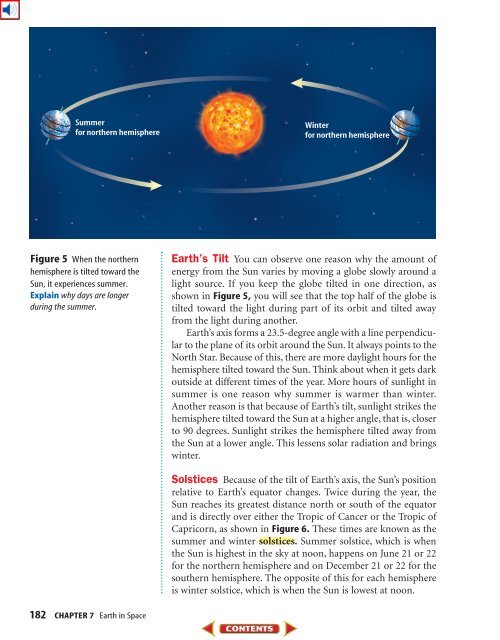Chapter 7: Earth in Space
Chapter 7: Earth in Space
Chapter 7: Earth in Space
Create successful ePaper yourself
Turn your PDF publications into a flip-book with our unique Google optimized e-Paper software.
Summer<br />
for northern hemisphere<br />
Figure 5 When the northern<br />
hemisphere is tilted toward the<br />
Sun, it experiences summer.<br />
Expla<strong>in</strong> why days are longer<br />
dur<strong>in</strong>g the summer.<br />
182 CHAPTER 7 <strong>Earth</strong> <strong>in</strong> <strong>Space</strong><br />
W<strong>in</strong>ter<br />
for northern hemisphere<br />
<strong>Earth</strong>’s Tilt You can observe one reason why the amount of<br />
energy from the Sun varies by mov<strong>in</strong>g a globe slowly around a<br />
light source. If you keep the globe tilted <strong>in</strong> one direction, as<br />
shown <strong>in</strong> Figure 5, you will see that the top half of the globe is<br />
tilted toward the light dur<strong>in</strong>g part of its orbit and tilted away<br />
from the light dur<strong>in</strong>g another.<br />
<strong>Earth</strong>’s axis forms a 23.5-degree angle with a l<strong>in</strong>e perpendicular<br />
to the plane of its orbit around the Sun. It always po<strong>in</strong>ts to the<br />
North Star. Because of this, there are more daylight hours for the<br />
hemisphere tilted toward the Sun. Th<strong>in</strong>k about when it gets dark<br />
outside at different times of the year. More hours of sunlight <strong>in</strong><br />
summer is one reason why summer is warmer than w<strong>in</strong>ter.<br />
Another reason is that because of <strong>Earth</strong>’s tilt, sunlight strikes the<br />
hemisphere tilted toward the Sun at a higher angle, that is, closer<br />
to 90 degrees. Sunlight strikes the hemisphere tilted away from<br />
the Sun at a lower angle. This lessens solar radiation and br<strong>in</strong>gs<br />
w<strong>in</strong>ter.<br />
Solstices Because of the tilt of <strong>Earth</strong>’s axis, the Sun’s position<br />
relative to <strong>Earth</strong>’s equator changes. Twice dur<strong>in</strong>g the year, the<br />
Sun reaches its greatest distance north or south of the equator<br />
and is directly over either the Tropic of Cancer or the Tropic of<br />
Capricorn, as shown <strong>in</strong> Figure 6. These times are known as the<br />
summer and w<strong>in</strong>ter solstices. Summer solstice, which is when<br />
the Sun is highest <strong>in</strong> the sky at noon, happens on June 21 or 22<br />
for the northern hemisphere and on December 21 or 22 for the<br />
southern hemisphere. The opposite of this for each hemisphere<br />
is w<strong>in</strong>ter solstice, which is when the Sun is lowest at noon.

















